The iPad Air Review
by Anand Lal Shimpi on October 29, 2013 9:00 PM ESTiPhone to iPad: CPU Changes
Although the iPad Air uses the same A7 from the iPhone 5s (and M7 motion coprocessor), there are a few minor differences that do lead to better performance.
At a high level we’re still talking about two 64-bit Apple Cyclone cores with 128KB L1s (64KB I$ + 64KB D$) per core, a shared 1MB L2 cache and a 4MB L3 cache that services the entire SoC. Apple increased CPU frequency from 1.3GHz to 1.4GHz in the iPad Air, a mild increase but in line with what we’ve seen from previous iPad designs. That’s the first impact on performance - a 7.69% increase in CPU frequency.
The second impact on performance is something I only noticed while digging around under the hood of the A7. It seems like the implementation in the iPad Air can, for whatever reason, hold more instructions in flight (over 20% more) than the A7 in the iPhone 5s. It’s unclear to me whether the A7 in the iPad is configured any differently via firmware/microcode or if perhaps we’re looking at a slightly different revision of the core, but the delta was repeatable in my testing.
The third, and likely biggest change impacting the iPad Air’s implementation of the A7 is the additional thermal headroom afforded by the larger chassis. I’m not going to go into details on exactly what this next test does (unfortunately we’re going to occlude some of the low level work that we do in light of all of the benchmark cheating going on), but we’re looking at a curve of performance vs. time for a particularly power heavy mix of code. We’re running the same exact code on both the iPad Air and iPhone 5s here, the only real difference is the size of the chassis:
You can see the 5s throttles back its CPU frequency to about 1GHz after the 2 minute mark. The crazy thing is that until that point the 5s manages to run at full frequency without so much as a hiccup for two full minutes, running an incredibly power hungry task. Given that most iOS apps aren’t this power intensive for such a sustained period of time, iPhone 5s users should almost always see the A7 running at a full 1.3GHz. Pretty crazy.
The iPad Air by comparison shows much more controlled behavior. Early on in the test we see a 7.7% performance advantage, which lines up perfectly with the iPad Air’s 7.7% CPU frequency advantage. By the end of the test the iPhone 5s has throttled to 900MHz, while the iPad Air drops to around 1.2GHz. At this point the iPad Air’s performance advantage grows to almost 40%.
CPU Performance
I've gone through our standard set of cross-platform browser based benchmarks to place the iPad Air's performance in perspective. As I mentioned in our 5s review, I don't know that there are many (any?) applications on iOS 7 that can really take advantage of all the A7 has to offer. There's definitely a ton of headroom left in the design. What's particularly exciting is when the A7 ends up in n-1 or n-2 iOS devices and it becomes the minimum developer target going forward.
I won't go through all of the results here again, but it's safe to say that the iPad Air is the fastest ARM based tablet on the planet at this point.
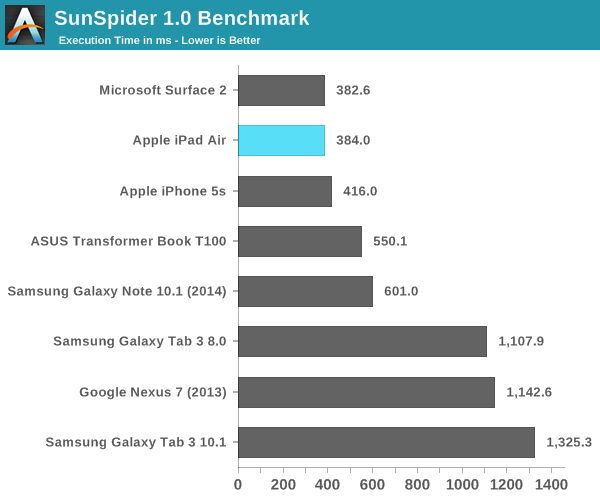
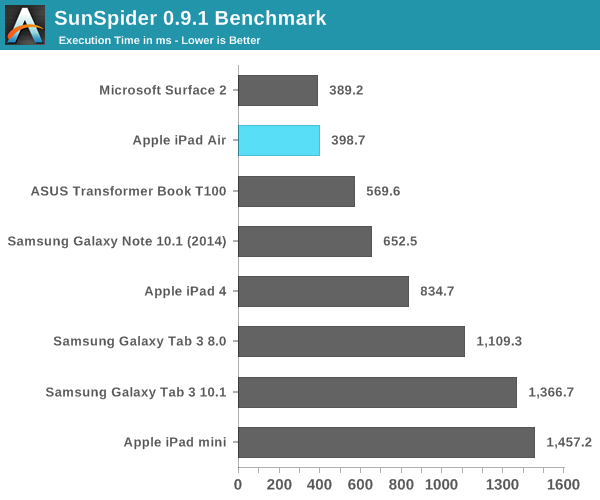
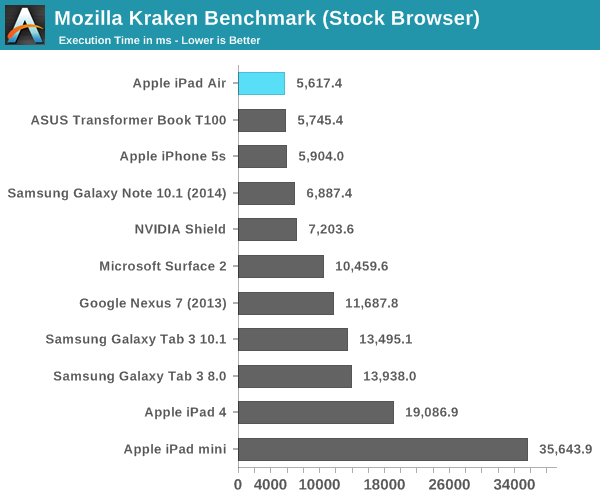
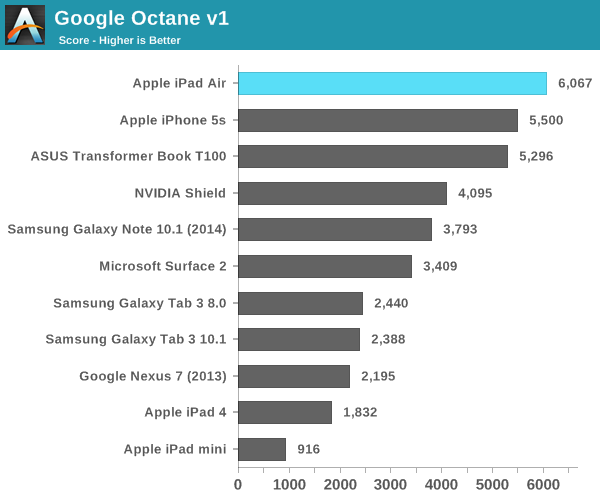
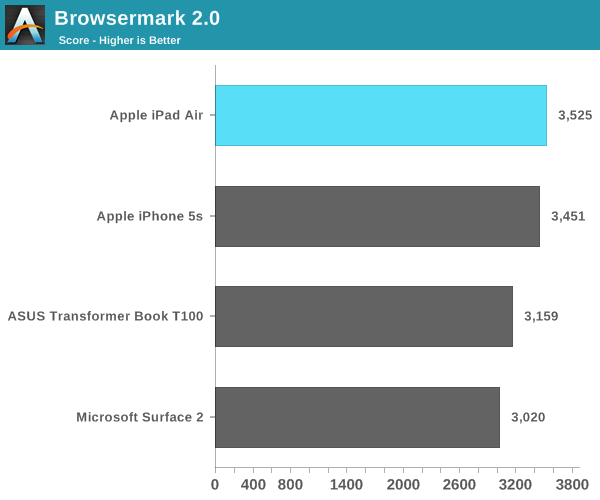

A7 Power Consumption
I’ll get to battery life in a bit, but I’ve been curious about the dynamic range of power consumption offered by Apple’s new A7 SoC. On the one hand we’re dealing with a lower power process (28nm vs. 32nm), but on the other hand Apple’s Cyclone cores can clearly draw more power given how beefy the architecture is this round. Apple frowns upon review sample dissection so I had to turn to a less scientific method of external platform level power measurement. The fidelity of the numbers here aren’t all that great but it’s better than nothing.
For the first test I measured platform power consumption during a Kraken run:
I purposely started measuring before the benchmark so I could get an idea of idle power consumption. The iPad Air consumes roughly 72% of the idle power as the iPad 4, both running at the same brightness. Here we’re not just seeing the A7’s advantages but also things like lower display power.
Focusing on the load portion of the measurement we see that both the new iPad and old iPad consume the same total power in this test. I suspect the A7 is drawing more power than the A6X, but it’s masked by a lower power display. Given how much faster the iPad Air is, Apple’s latest tablet features far lower overall task energy than the outgoing iPad 4. This is probably both the best case scenario for the iPad Air and the most likely case as well.
For kicks I wanted to see just how much power I could get the iPad Air to draw. Here I’m looking at platform power during our mini-power-virus test from above:
How’s that for dynamic range? Almost 12W running all out, but around half that in what we’d normally consider to be a stressful CPU test. I couldn’t get any actual applications/games on the iPad Air to behave like this so the results above are purely academic (for now). A quick run through GFXBench 2.7’s T-Rex HD test confirms that even pushing the GPU won’t hit these numbers. The max I saw running T-Rex offscreen was ~6W, and turning to an actual game (Infinity Blade 3) the iPad Air pulls less than 5W.


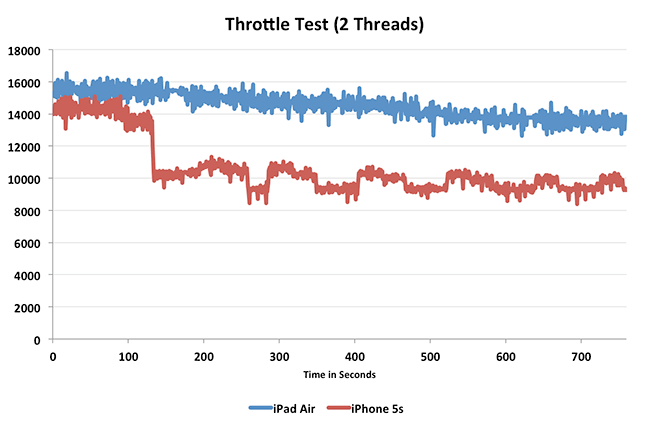
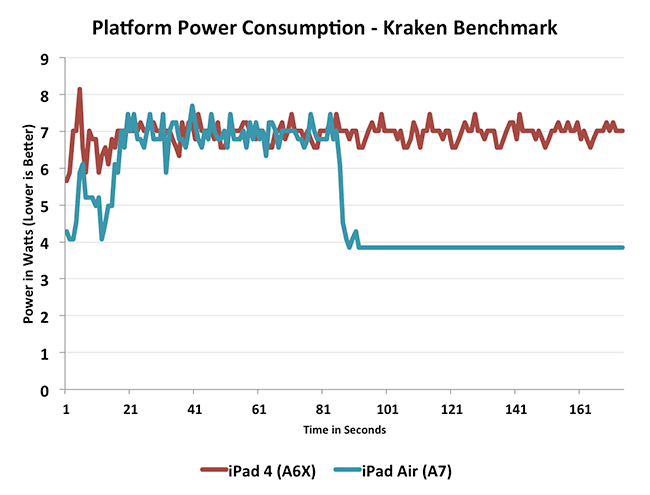
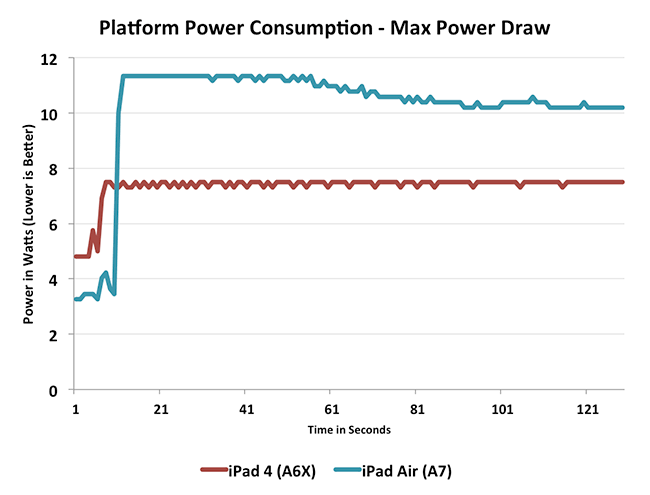








444 Comments
View All Comments
over9k - Tuesday, October 29, 2013 - link
Remember, Mavericks' big focus is RAM management. There's no reason to think iOS 7 also doesn't do some great RAM management. It's just that when talking mobile, that's not the "it" talk. Also, it's important to note that iOS devices have always used lower amounts of memory - they are just very well optimized.tipoo - Tuesday, October 29, 2013 - link
Mavericks borrowed how iOS already used memory, with background apps being able to be pushed out of memory if need be. iOS7 isn't getting Mavericks memory management, Mavericks is just getting the management iOS already had since its inception.kirsch - Tuesday, October 29, 2013 - link
I think over9k is referring to memory compression introduced in Mavericks. As far as I know this was never in iOS.tipoo - Tuesday, October 29, 2013 - link
The compression seems to work on idle apps too though, and iOS would run only one foreground app with most of the memory available to it. I just don't think it will help as much on a mostly single tasking OS.NetMage - Wednesday, October 30, 2013 - link
Actually it should help more as the recent Apps on iOS are mostly don't to run at all, but are kept in memory to improve swapping speed - these could be easily compressed with no impact on user experience.tipoo - Wednesday, October 30, 2013 - link
People saying Mavericks like compression will help: Anand measured how much RAM was in use under load. If it was compressing something, it would have been factored into how much was used. This is no holy grail here.darwinosx - Wednesday, October 30, 2013 - link
You think it needs 2 GB of ram why? It obviously doesn't. This isn't Windows or Android.DarkXale - Wednesday, October 30, 2013 - link
Because Safari is famous for resetting tabs (lost work), and many iOS apps are notorious for dropping undo states the very second you switch out of them. (Which you have to due to the inability to display more than one app at a time)Both cause data loss, which is one of the most serious events that can occur in computer systems.
Both are due to RAM constraints.
dugbug - Wednesday, October 30, 2013 - link
I have not seen that in ios7, they rewrote that behavior significantly. Would it benefit from more ram? sure. Or they could just rewrite it to cache tabs better.tipoo - Wednesday, October 30, 2013 - link
Because even with 30% less RAM use on 32 bit iOS, Safari boots tabs out like crazy and has to reload a lot of apps from NAND when switching.